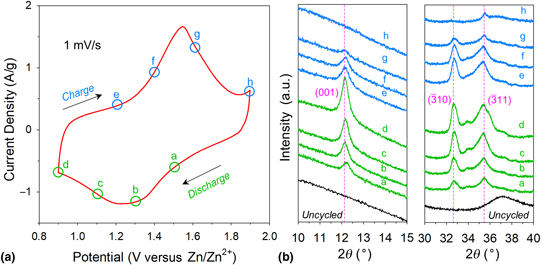Crossref Citations
This article has been cited by the following publications. This list is generated based on data provided by
Crossref.
Nam, Kwan Woo
Kim, Heejin
Choi, Jin Hyeok
and
Choi, Jang Wook
2019.
Crystal water for high performance layered manganese oxide cathodes in aqueous rechargeable zinc batteries.
Energy & Environmental Science,
Vol. 12,
Issue. 6,
p.
1999.
Ko, Jesse S.
Lai, Chun-Han
Long, Jeffrey W.
Rolison, Debra R.
Dunn, Bruce
and
Nelson Weker, Johanna
2020.
Differentiating Double-Layer, Psuedocapacitance, and Battery-like Mechanisms by Analyzing Impedance Measurements in Three Dimensions.
ACS Applied Materials & Interfaces,
Vol. 12,
Issue. 12,
p.
14071.
Owusu, K.A.
Pan, X.
Yu, R.
Qu, L.
Liu, Z.
Wang, Z.
Tahir, M.
Haider, W.A.
Zhou, L.
and
Mai, L.
2020.
Introducing Na2SO4 in aqueous ZnSO4 electrolyte realizes superior electrochemical performance in zinc-ion hybrid capacitor.
Materials Today Energy,
Vol. 18,
Issue. ,
p.
100529.
Sassin, Megan B.
Helms, Maya E.
Parker, Joseph F.
Chervin, Christopher N.
DeBlock, Ryan H.
Ko, Jesse S.
Rolison, Debra R.
and
Long, Jeffrey W.
2021.
Elucidating zinc-ion battery mechanisms in freestanding carbon electrode architectures decorated with nanocrystalline ZnMn2O4.
Materials Advances,
Vol. 2,
Issue. 8,
p.
2730.
Cabana, Jordi
Alaan, Thomas
Crabtree, George W.
Hatzell, Marta C.
Manthiram, Karthish
Steingart, Daniel A.
Zenyuk, Iryna
Jiao, Feng
Vojvodic, Aleksandra
Yang, Jenny Y.
Balsara, Nitash P.
Persson, Kristin A.
Siegel, Donald J.
Haynes, Christy L.
Mauzeroll, Janine
Shen, Mei
Venton, B. Jill
Balke, Nina
Rodríguez-López, Joaquín
Rolison, Debra R.
Shahbazian-Yassar, Reza
Srinivasan, Venkat
Chaudhuri, Santanu
Couet, Adrien
and
Hattrick-Simpers, Jason
2022.
NGenE 2021: Electrochemistry Is Everywhere.
ACS Energy Letters,
Vol. 7,
Issue. 1,
p.
368.
Rolison, Debra R.
Sassin, Megan B.
and
Long, Jeffrey W.
2023.
Springer Handbook of Aerogels.
p.
1305.
Chen, Xiujuan
Li, Wei
Reed, David
Li, Xiaolin
and
Liu, Xingbo
2023.
On Energy Storage Chemistry of Aqueous Zn-Ion Batteries: From Cathode to Anode.
Electrochemical Energy Reviews,
Vol. 6,
Issue. 1,
Li, Wenbin
Song, QianQian
Dong, Qi
Zhang, Jianhua
Wang, Jingjing
Wu, Yumei
Yu, Yan
and
Li, Xifei
2025.
Proton Storage Chemistry in Aqueous Zinc‐Inorganic Batteries with Moderate Electrolytes.
Advanced Materials,
Vol. 37,
Issue. 10,
